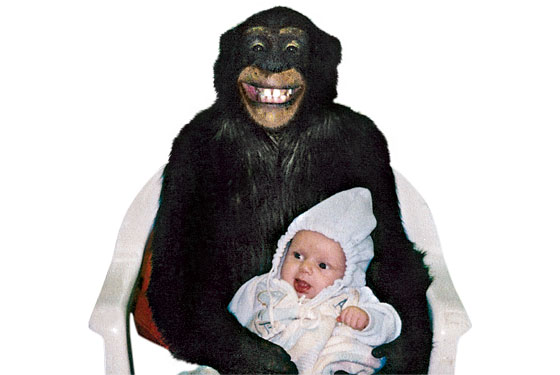
Throughout her life, Sandy Herold had long, straight hair so black it almost looked wet. She wore it down below her shoulders, her bangs cut straight across. She applied bright-pink lipstick and copious amounts of bronzer. She wore skintight size-7 jeans. She spoke with a strange accent, a New York–New England hybrid, and spent her entire life in Stamford, Connecticut.
She was born in 1938 to a Jewish mother and Italian father who operated a popular bakery downtown and eventually built an unassuming shingled house on a windy road called Rock Rimmon, to the north of the city. As an only child, Sandy spent much of her time playing with her German shepherd Gretchen and tending to the horses on the property. At birthdays, her parents outfitted her in silk dresses and cardigans and had her pose for photographs, smiling, near multitiered cakes, Gretchen standing at her side.
She married shortly after high school, then again in 1960. Her second marriage was romantic, intense, and desperate—she adored her new husband, with whom she had a daughter named Suzan, in 1961, but they fought violently over his frequent affairs and divorced after four years. At 30, Sandy married her third husband, Jerry Herold, who was kind, intelligent, and devoted. Her life stabilized; she, Jerry, and Sue, whom Jerry raised as his own, ultimately settled in the house on Rock Rimmon Road with Sandy’s parents. Sandy and Jerry opened several businesses in Stamford, including a tow operation and an auto-body shop, that would soon make them unlikely millionaires.
For a time in the seventies, Sandy, Sue, and Jerry towed their horses from state to state so that Sandy (and later Sue) could barrel-race semi-professionally in rodeos. It was during a stint with the country singer Loretta Lynn’s traveling rodeo that Sandy struck up a lifelong friendship with an 18-year-old runaway named Charla Nash, who was rodeoing her way around the country. One day, Sandy and Charla spotted a chimpanzee dressed in Westernwear who rode a horse around the ring. Sandy sought him out backstage. She was carrying gummy bears. He took them from her with his fingers. Later, back atop his horse and wearing a cowboy hat, the chimp spotted Sandy in the audience. He jumped down, ran on two legs, and leaped into her arms.
Between the expanding businesses, the horses in the yard, and their many dogs, the Herolds lived a happily frenetic life. Sue grew into a platinum-blonde version of her mother. The two raced side by side, country-line-danced, worked together at the businesses. Mother and daughter were engaged in one endless conversation. And so when Sue married an employee from her parents’ shop and moved away, Sandy was bitter and heartbroken. Then each of her parents became sick and died. Her world narrowed further. Seemingly all of a sudden, she saw herself and Jerry drifting beyond the outer periphery of middle age.
Jerry was home tending to the businesses as Sandy landed at the Lambert–St. Louis International Airport one day in 1995. A few days earlier, she had received a call from Connie Casey, a breeder in Festus, Missouri, a rural town 35 miles south of St. Louis. “Sandy,” she said, “your baby has arrived. It’s a boy.”
Sandy stood in the Caseys’ living room. In her arms, swaddled and in a diaper, lay tiny Travis—named after her favorite singer, Travis Tritt. Travis was the son of Coco, who’d been snatched from the jungles of equatorial Africa in the early seventies and purchased for $12,000, and an 11-year-old retired zoo chimp named Suzy. A day earlier, the Caseys had shot a tranquilizer in Suzy and removed Travis from her cage. Travis peered up at Sandy. Black hair covered all but the interior of his face, which was pink, and the two tiny Dumbo ears that jutted from the top of his head. Sandy cried as his hands and feet grasped at her. She paid the Caseys $50,000 in cash, and a few days later, with Travis wrapped in baby blankets, the two of them boarded a flight home.
Back in Stamford, Sandy and Jerry played with Travis, who absorbed their smells and cues and began learning their language. Sandy bottle-fed him formula, burped him, put him down for naps in a crib in their bedroom. At 3 months, he turned over. Soon he was scooting, then walking on his arms and legs, his knuckles absorbing much of his weight. They taught him to use the toilet. They joined him in the bathtub. They brushed his teeth, and later taught him to brush his own teeth. Sandy bought him an extensive wardrobe and dressed him every morning.

The Herolds retrofitted their house to accommodate Travis. They caged in a large room in the rear, which had a set of sliders that led to an outdoor enclosure. They installed a heavy, lockable metal door on their bedroom, creating a suite of rooms, including the caged room, where Travis could roam freely when he was left alone. When Sandy and Jerry were home, Travis had the entire house at his disposal, knuckle-running from the couch in the living room to the kitchen, swinging from the tires and ropes in his room, jumping on his bed. The Herolds also laid a mattress on the floor of their bedroom, though most nights Travis slept in bed with them.
Sandy and Jerry took Travis to work with them every day. They installed tire swings, ropes, and trampolines in a giant room above the tow shop. He was inquisitive and friendly. Even the tow drivers and mechanics melted when they saw him.
These were some of the happiest days of Sandy’s life. By then, Sue had divorced her first husband, and she and her young son had returned to Stamford, moving into a spacious loft-style apartment her parents constructed next to the auto-body shop. Sandy and Sue worked together every day, in the room above the tow shop, with Travis. They joked, gossiped, talked about men. Sue’s son, Tyler, and Travis were close in age, and they played well together; as Travis matured more rapidly than Tyler, his fondness for the boy grew, so that he often held him in his lap, kissing him.
Travis grew quickly. Jerry played catch with him and taught him to ride a tricycle (which was awkward at first, what with his long arms), then a bike, then a ride-on lawn mower. Sandy put on a blue bikini and big gold-hoop earrings and took him to the beach, carrying him into the water with her.
Sandy and Jerry invited Travis to join them at the table for meals. He ate oatmeal with a spoon every morning. At their favorite Italian restaurant, Pellicci’s, she read him the menu, offering him choices. His favorite food was filet mignon. He also enjoyed lobster tail. He preferred Lindt’s chocolates. He liked Nerds candy and taffy, and he loved ice cream, hooting and pulling at Sandy when the ice-cream man came down the street. When he was thirsty, he swung his body up onto the counter and took out a glass, opened the refrigerator, and poured himself juice or soda.
Travis had a distinct sense of humor. He’d become particularly impish when Sandy was on the phone talking. He’d change the channels of the remote furiously. He’d blast the volume on the TV. “Cut it out, you little son of a bitch!” Sandy would yell, and then laugh. “I’m gonna kill you, you little bastard!”
“I’ll tell you,” she’d say into the phone, “you should see how smart Travis is. Just today he …” Sandy was ceaselessly dumbfounded by Travis’s humanness. Though she did not know their name, she seemed to intuit the so-called spindle cells in his brain, cells shared by humans and chimps that are believed to help us to process complex thoughts and empathize.
Sandy’s old friend Charla Nash came to visit, bringing with her her young daughter, Briana. They sat outside, Charla playing with Travis, the chimp climbing all over her, messing with her long blonde hair, the two of them posing for pictures. He climbed the tall oak trees around their property, racing up them, jumping from one to the next.
Travis quickly became Stamford’s most famous resident. The Herolds plastered his image on the side of their tow trucks and flatbeds. He sat shotgun on tow calls, waving as the truck pulled up. He came to love police officers especially, and virtually everyone on the force had his photo taken with him. Strangers approached in stores, on the street. Sometimes they handed him their babies to hold.
One fall day, a neighbor was out raking leaves. Across the street, he noticed a Corvette coming down the Herolds’ driveway. It was Travis’s favorite car—he perceived it as his own, Sandy said—and in fact there were rumors that Travis had once taken the keys and gotten behind the wheel, turned the ignition, and, half-standing in the driver’s seat, his opposable-thumbed feet grabbing the pedals, steered the car down the driveway and out onto Rock Rimmon Road. The man raking leaves watched as the car drew closer. Dressed in animal prints and decked to the nines, Sandy was driving, with Travis, in a ball cap and T-shirt, sitting beside her; the windows were down, and each had an arm hanging out. Reflexively, the man raised his hand. Sandy and Travis both waved back.
When Travis was around 5 years old, Sue fell in love and married again. She had two more children. She and her husband eventually decided to relocate near the Outer Banks, where he was opening a mechanic’s shop. Sandy did not take kindly to the news. Again, she felt abandoned; again she disapproved of Sue’s husband. Within a few months, however, Sandy was calling to tell Sue she couldn’t stand not talking every day. She sent money and gifts down to North Carolina. Every note Sue mailed to her mother, no matter how banal, Sandy read repeatedly, showed repeatedly to Jerry, and bound in plastic for safe keeping.
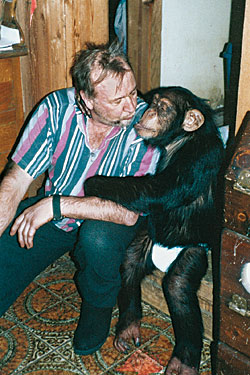
Sue was making repeated trips to Connecticut to retrieve their remaining belongings. On her way home one night in September 2000, Sue, who’d complained of back pain and taken a Percocet, was driving on a mostly empty highway. Somewhere in Virginia, her car left the roadway and collided with a tree. Her infant daughter, strapped in her car seat, was unscathed. Sue was ejected from the car. The phone rang inside Rock Rimmon Road, waking Sandy, Jerry, and Travis, all asleep in bed.
At an open-casket viewing in Stamford, Sue’s body lay in a floral-print dress her mother had bought her. Beside her stood an enlarged photo of her in the same dress, holding her newborn daughter. Sandy was anything but stoic in her mourning. She stalked the room, gasping, and blocked certain visitors from coming inside. “That’s that bastard!” she shouted at Sue’s husband. “If it wasn’t for him my daughter would be alive!”
In the years after Sue’s death, Sandy vacillated between combustible anger and unrelenting depression. She struggled to maintain relationships with Sue’s children. She distanced herself from her friends and at one point considered suicide. Her life was now built almost entirely around Jerry and Travis, and when she finally began venturing out of the house again, it was with the two of them. One bright winter day, they all drove down to the sea. They walked out onto the beach holding hands, in a line straight across; it was Travis who held their dog Apollo’s leash. Sandy now considered Travis her only child.
Travis quickly moved beyond the gangly phases of early adolescence, through puberty, and into early adulthood. One night after work, Jerry was sipping a glass of wine when Travis climbed up into the seat next to him. Travis was interested in what he was drinking. Jerry offered him a sip. Thus began their nightly ritual: a glass of wine, one for Travis, one for Jerry, served in stemware, which they clinked together as Jerry said cheers.
Travis was also growing more willful. Three years had passed since the death of Sue. It was a warm night in October 2003. Jerry, Sandy, and Travis had eaten a dinner of sausage and peppers and were sitting on the couch watching the World Series. Travis was an avid TV watcher, and he particularly liked sports. All three were cheering for the Yankees. Sandy and Jerry decided they needed to make a trip to the tow shop. They asked Travis whether he had any interest in a ride. It was a rhetorical question.
They were in the 4Runner, stopped downtown at the intersection of Tresser and Washington Boulevards, when someone, for reasons unknown, threw an empty soda bottle into Travis’s partially open window. Travis looked, grunted, unbuckled his seat belt, unlocked and opened the door, and began knuckle-running across the road.
He stood, surveying the area in his extra-large adult diaper (though he was potty-trained, he often wore diapers when he was out). At one point, he lunged at a passerby. And then, all of a sudden, he lay down in the street and began rolling on his back. People in their cars honked and pointed. Traffic at the intersection came to a standstill. Neighbors came out to watch.
Travis was clearly enjoying himself, climbing over cars, hooting, smiling. He chased the dozen police officers who responded to the call for a “loose chimpanzee downtown.” The spectators cheered for him as he evaded capture, smacking several officers on their behinds. Cookies and ice cream could not coax him back. Each time they lured him into the 4Runner, Travis opened the door and got out again before they could lock it. This continued for two hours.
Finally, when he began to tire, Travis climbed into the SUV and buckled his seat belt. No charges were pressed; several of the police officers who knew Travis personally wrote in their reports that his attitude was only playful. They escorted the Herolds home. Travis spent the next day in his room, grounded.
Virtually everyone made light of the escapade downtown. The state Department of Environmental Protection was aware of what happened, and also that the Herolds were in violation of a new statute that required a permit to keep a primate over 50 pounds. But they determined that pressing any action would amount to a most likely unwinnable battle to “take custody of a local celebrity” and opted not to pursue the matter.
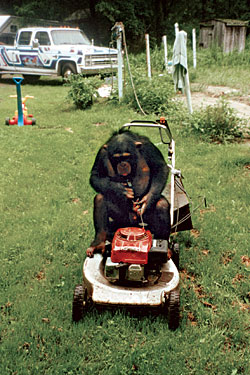
Stamford’s animal-control officer was more concerned. After contacting primatologists, she spoke with Sandy, arguing that Travis was by now a fully sexualized adult (chimpanzees in the wild have sex, nonmonogamously, as often as 50 times a day); that he had the strength of at least five men; that adult chimpanzees are known to be unpredictable and potentially violent (which is why all chimp actors are prepubescent); and that maintaining Travis for the duration of his five- or six-decade lifetime was not viable. Sandy seemed to pay an open mind to the officer’s warning but ultimately concluded that Travis had never exhibited even the slightest capacity for violence.
There was one piece of information, however, that Sandy chose not to share with the officer. Two years earlier, the Herolds had received a phone call from Connie Casey, the breeder in Festus. She explained how Travis’s parents, Suzy and Coco, had escaped their cages and, with a third chimp, run across the ranch to a nearby housing development, where a 17-year-old named Jason Coats and some friends were pulling into Coats’s driveway on their way home from the Dairy Queen. Coats claimed the chimps approached his Chevy Cavalier and trapped the teenagers inside, baring their teeth and rocking the car. Coats eventually got out, ran into his house, and grabbed a shotgun. Casey had by then arrived at the driveway and tranquilized Suzy, who was now, according to Casey and several eyewitnesses, sitting at the edge of the road, stoned, fingering the grass and flowers. Casey begged Coats not to shoot. He fired three rounds at Suzy; she died two hours later.
Following several neighbors’ testimony that the chimps were behaving playfully and had posed no threat, a jury found Coats guilty of property damage and animal abuse, and he served a month in jail. Coats nevertheless remained steadfast in his belief that the chimps were dangerous.
The Herolds stopped taking Travis out in public after the incident in downtown Stamford, and they spent most of their time away from work at home with him. One night, over takeout spaghetti dinners at the kitchen table, Travis was sulking. He was sitting next to Jerry, facing away from him. Jerry was eating heartily, after some dental work he’d had earlier in the day. Jerry and Sandy were trying to engage Travis.
“Daddy got his tooth fixed today,” Jerry said. “Look.”
Travis wouldn’t.
“Come on, Trav,” Sandy said. “Look at Daddy’s new tooth.”
Travis turned, glanced begrudgingly.
“Come on, Trav,” Jerry said. “Which tooth had a boo-boo? Which one?”
Travis looked finally. Jerry opened his mouth.
“Which one?”
Travis looked for a second before extending his long index finger. He placed the tip of it directly on Jerry’s left molar. Sandy and Jerry cheered: “That’s the one, Travis! That’s the one!” Travis’s lips curled open around his gleaming white teeth. He bounced in his chair and buried his face in Jerry’s chest.
“Show Daddy your teeth now,” Sandy told him. Travis looked at her, looked at Jerry, puckered his lips again, exposed his teeth, and tilted his head up toward Jerry. Jerry cheered.
“Show Daddy your big tongue now!” Sandy said. Travis opened his mouth and unfurled his giant pink tongue. Once again, they cheered. By now Travis could not contain himself: He smiled broadly and grunted, his shoulders shaking in silent laughter. He patted Jerry on the back. Finally he wrapped his long arm around him.
Occasionally, Jerry complained that he wasn’t feeling well. After playing with Travis one morning in March 2005, he went off to work, where his discomfort sharpened. He asked one of his employees to take him to the hospital.
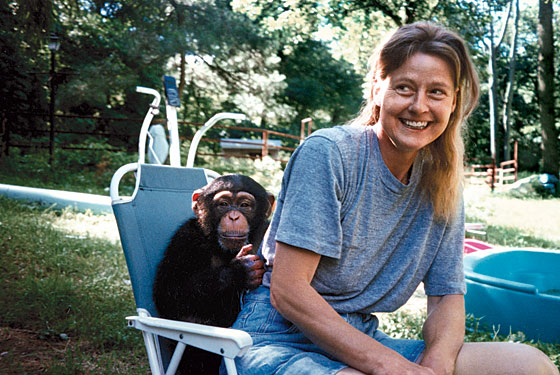
Over the course of Jerry’s weeks-long stay, during which his doctors tried to arrest his rapidly spreading stomach cancer, Sandy spent virtually every minute at the hospital. One night he said he wanted to talk to her about Travis. He asked her what she would do if he were to die—if it were to become just her, alone with Travis. As much as he said it pained him, he urged her to send Travis to a sanctuary. He told her Travis was too much for her to manage alone. He said it was best for both of them.
When Sandy arrived home from the hospital, Travis smelled her clothing frantically, inhaling Jerry’s scent. He was at first disoriented by Jerry’s sudden absence, then despondent. Several times Sandy put Travis on the phone to talk to Jerry; each time Travis became so upset that she had to take the phone away. Travis sat rocking back and forth for hours. He lifted pictures of Jerry off the wall, put his lips to the glass, held them to his chest. Sandy took them all down and put them in a box. On April 12, Jerry died.
After Jerry’s death, Sandy ignored condolences and stopped speaking to many of her friends. Travis continued his rocking. When she sat on the sofa crying, Travis gently brushed her hair. He bit her nails and used an emery board to file them.
When almost a year had passed, Sandy sat down to write a letter. She drafted it in longhand, and addressed it to a woman in Florida who runs a respected chimpanzee sanctuary. These were the last two paragraphs.
“Needless to say, after 45 years with the most wonderful man in the world we are both lost without him and miss him dearly. Travis still waits for him especially at supper time, because at that time they both had a glass of wine with their supper and if my husband ever cooked anything you can bet it has garlic in it. Try having two guys breathing on your sleep time with (garlic breath). Travis would go to the bedroom window many nights sit on the bench seat look out, get very vocal and happy then come back to sleep, this was always very late at night. Finally I went to psychic and she told me Jerry would visit at night and talk to Travis and my husband would always kiss me good night. P.S. (him and Travis kiss alike) that’s good too.
“I have no family, my only child, Suzan had gotten killed in an auto accident 4 years before Jerry died and who Travis also loved. My grand kids live in North Carolina and I don’t see them very often. I live alone with Travis, we eat and sleep together but I am worried that if something happens to me as suddenly as my husband what would happen to Travis, therefore I have to try to do something before that happens. I set up a trust fund for him but that’s not enough, he needs someone to play with of his own kind and have the best most possible life if I’m not here to care for him. I would love to see and talk to you if that’s possible. I am flying down to see your member event enclosed is our donation. I am looking forward to meeting you.”
She signed the letter, “Sandy (Jerry) and Travis,” and enclosed photos of Travis and the family. She wrote out a check for $250, signing it from both her and Travis. She put everything in a stamped envelope. She never mailed the letter and never made the trip.
Charla Nash and Sandy reunited around the time of Jerry’s death. Charla and her then-12-year-old daughter had lived itinerantly, at one point staying for more than a year in a homeless shelter. Charla had taken odd jobs, picked up occasional yard work, cleaned horse stalls. The reunion was mutually beneficial: Sandy invited Charla and her daughter to move rent-free into the loft apartment that had once been Sue’s. She gave Charla a job, handling towing dispatch and bookkeeping. Over time the terms of Charla’s employment blurred. Charla tended to Sandy’s lawn and would look in on Travis if Sandy was away.
She rarely was. For four years, Travis never left home, and Sandy only sporadically did, aside from compulsive shopping trips: She spent hundreds of thousands of dollars at stores like T.J. Maxx and Marshalls, stuffing bags of clothes in dozens of plastic bins that filled almost every room of the house. She and Travis relegated themselves to the kitchen and the suite in the rear of the house. In early 2008, construction was under way on a gigantic new addition that Jerry had designed for Travis years earlier. Travis, by this point, no longer bore much physical resemblance to his former self. He was 14 years old, five feet tall, 240 pounds, and morbidly obese. His hairline had receded dramatically, and his center torso had gone gray. His face was black and wrinkled. His chest sagged. He spent the majority of his days snacking, watching TV, playing on the computer, and roaming the house.
It was February 16, and Sandy and Charla had just returned from a weekend at the Mohegan Sun casino; before leaving, Sandy had taken Charla to get her hair colored and curled, in case, Sandy had joked, two eligible bachelors crossed their paths. Sandy had offered Charla some gambling money. At dinner one night, Sandy had opened her purse and showed the waiter several pictures of Travis. “Do you think he looks more like his mom,” she had asked, “or his aunt?”
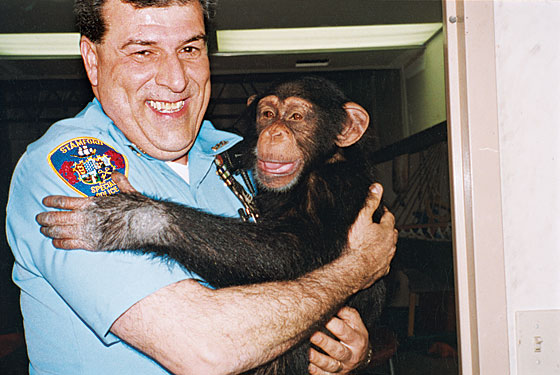
Now it was after 3 p.m., and Sandy was in a bit of a panic. She was meeting a friend, and as she’d been cleaning Travis’s room, he’d walked into the kitchen, picked up the keys from the counter, unlocked the door, and ventured out into the yard. He’d seemed agitated for a good part of the day; after eating a lunch of fish and chips and Carvel ice-cream cake, he’d not been particularly interested in watching any of the three TVs that were playing in the house. He did not want to draw or color. He did not want to pet his cat, Misty. Even the smorgasbord of food—the Popsicles in the freezer she’d labeled for him with R for red and F for Fudgsicle, the steam-in-a-bag vegetables he liked to toss in the microwave himself—was unappealing. Sandy, slightly concerned, had dropped a Xanax in his mug of afternoon tea.
She was on the phone with Charla. She told her about Travis. He was outside, she said, running from car to car, apparently wanting to go for a ride; he’d ignored her entreaties to come back inside. Later, Sandy would say that Charla volunteered to come over and help; Charla would maintain she was asked. In any case, Charla arrived at about 3:40, opened the iron gate at the end of the driveway, and drove to the front of the house. She stepped out onto the frozen dirt and grass and held over her face a red Elmo doll she’d thought to bring with her. Travis was in the front yard, about 35 feet away. He knuckle-ran toward her, then came up on his two legs.
“Travis!” Sandy shouted. “Travis! What are you doing? Travis! Stop! Travis! It’s Charla, Travis!”
Travis knocked her into the side of her car. Then to the ground. Almost immediately, Charla turned red with blood. Sandy screamed and grabbed a nearby snow shovel. She ran to Travis and began beating him over the head. He was screaming, too, a terrible high-pitched screech. He continued at Charla, unyielding.
Hysterical, Sandy ran back to the house. She grabbed a butcher knife. She ran back, screaming all the while. As Travis stood over Charla, chewing, ripping, pulling, Sandy plunged the knife into his back. He did not stop. She pulled the knife out and stabbed him twice more, to little effect. Travis stood up finally, turned to look Sandy in the face—directly in the face—then continued.
Sandy ran to her Volkswagen Passat, parked about fifteen feet away. She got in and locked the door. She dialed 911, still holding the butcher knife.
“Stamford 911, where’s your emergency?”
“Two-forty-one Rock Rimmon Road, send the police!”
“What’s the problem?”
“Send the police!”
“What’s the problem there?”
“The—that—the chimp killed my—my friend!”
“What’s wrong with your friend?”
Sandy gasped, pressed her feet into the floor of the car to turn around and look, her face pushing the buttons of her cell phone. She sobbed.
“Oh, please! Send the police with a gun—with a gun—hurry up!”
“Who has the gun?”
“Please, hurry up! Please hurry up! He’s killin’ my girlfriend!”
“I need you to talk to me, I need you to calm down. Why do you need somebody there?”
“What? Please, God!”
“What is the problem?”
“He’s killing my friend!”
“Who’s killing your friend?”
“Chimp—my chimpanzee!”
“Oh, your chimpanzee is killing your friend?”
“Yes! He ripped her apart! Hurry up! Hurry up! Please!”
“What is going on? What is the monkey doing? Tell me what the monkey is doing.”
“He—he ripped her face off!”
“He ripped her face off?”
“Gun! They got to shoot him! Please! Please! Hurry! Hurry! Please!”
“Ma’am, ma’am, I need you to calm down. They’re already on their way.”
“I can’t. I can’t … He’s eating her! He’s eating her!”
“He’s eating her?”
“Please! God! Please! Where are they? Where are they?”
It went on for twelve minutes.
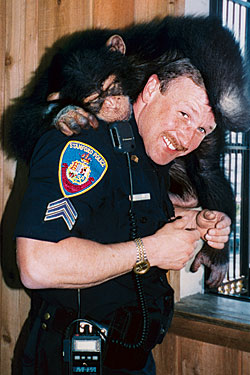
When the authorities finally arrived, they saw a body lying mostly naked on the ground, lifeless and covered in nearly half its blood supply. Travis was roaming the property. He made his way to the police car. He swatted off its driver’s-side mirror. He went to the passenger’s side and tried to open the locked door. He walked back around to the driver’s side. He tried the door. It opened.
The officer lurched. He struggled to remove his gun from its holster. His body became wedged against the center-console computer. Travis stared into the car, baring his blood-streaked teeth. In one swift motion the officer at last released his gun and fired four rounds. Travis staggered backward, screeched, defecated, and ran off.
The officer got out of his car. Huge chunks of scalp and fingers lay scattered around the yard. He walked slowly to the body. With the stump of what remained of her arm, Charla Nash reached for his leg.
As another group of officers set out into the woods to look for him, Travis scampered unnoticed into the house. Leaving a trail of blood, he knuckle-walked through the kitchen, the bedroom, and into his room. Then he grasped his bedpost, heaved forward, and died.
Charla Nash’s injuries were overwhelming. Travis had bitten or torn away her eyelids, nose, jaw, lips, and most of her scalp. He’d broken nearly all the bones of her facial structure. He’d fully removed one of her hands and virtually all of the other. He’d rendered her blind.
And yet she did not die. Three days after the attack, in critical condition, Charla was flown by specialized jet from Stamford to the Cleveland Clinic. Fifteen months of intervention followed.
One month after the attack, her family filed a $50 million lawsuit against Sandy.
Sandy was alone.
After weeks of blistering coverage, journalists from around the world—who, hoping to coax Sandy out of the house, had left her flowers, coffee, and sympathy notes—had finally moved on. The reporting had included many inaccuracies, such as the unsubstantiated assertion (which Sandy never disputed) that Travis was the same chimpanzee who had appeared in the iconic Old Navy ads of the nineties and on The Maury Povich Show. The New York Post had accused Sandy of “weird jungle love” and all but said that she and Travis had sexual relations. Even after the press mob had lost interest in her chimp, the allegation that hurt her most was that she’d cared more about Travis than Charla. “I stabbed my own son,” she cried to friends on the phone. For a long time, inside her house, she refused to clean up his blood. She sat a gigantic stuffed chimpanzee in the leather chair in his room.
“I just—you just—you can’t imagine,” she sobbed into the phone late at night. “They cut off his head!” She was referring to the last time she’d seen Travis, when she’d gone to the crematorium to drop off his favorite tie-dyed T-shirt and discovered he’d been decapitated for rabies testing.
She tried to reconstitute her life. She visited occasionally with friends, and made trips to the casino. She continued shopping—much of it for clothes for her three grandchildren that she would end up never sending—until her house became impassable. She sat at her kitchen table and leafed through stacks of mail, old letters, old pictures, doodling Sue’s name on the back of envelopes. She tuned in nightly to Bill O’Reilly. She talked—and cried—on the phone incessantly; the subject was almost exclusively Travis. One of her daughter’s friends helped her set up a profile on Match.com; she went on a date with an elderly Stamford man who appalled her by requesting oral sex as they were having dinner.
In the end, all that was really left for Sandy were animals. She put bowls outside for the raccoons. She fed deer in the yard from her hands. And she found another chimpanzee. His name was Chance. She knew she could never bring him back to Connecticut, so she contributed money to a friend out of state, and the two women were to assume a kind of joint custody. One spring day, she sat on a couch in the woman’s mobile home. Chance, about a year old, stretched his young, long body out across her lap. Sandy tickled his belly. He climbed all over her. The two of them snuggled and played. They opened their mouths wide and put them up against each other’s. Sandy’s makeup ran with her tears.
Back in Connecticut one day last summer, shortly before sunset, Sandy was alone, outside, feeding the animals. She looked up. A cloud formation resembling a fish’s backbone was unspooling against the sky. She found her camera, held it up, and clicked.
Sometime later, her chest began hurting. The pain came on quickly and intensified. Frightened, she called a friend, who drove over to her house to sit with her. A hot bath provided no relief. The friend called 911. She put Sandy in her car, in her pink bathrobe and slippers, and drove her down Rock Rimmon Road, to meet the ambulance on its way.
At the ER, tests determined Sandy’s aorta was bulging. She was prepared for emergency surgery. In the operating room, two hours in, Sandy’s lungs filled with blood.
And then they were all gone. All the Herolds were dead.
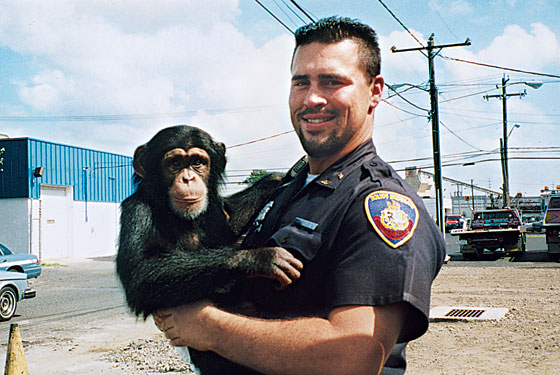
Last May, Charla Nash was transferred to a long-term assisted-living facility outside Boston. The innumerable cosmetic surgeries she has undergone have accomplished little cosmetically. On her 56th birthday, nine months after the attack, in what will undoubtedly go down as one of the most extraordinary moments in television history, she revealed her face—a bulbous surface of transmogrified skin—to Oprah Winfrey; she told Winfrey she remembers nothing from the attack and is disinclined to worry about how others see her. “I just look different,” she said. “Things happen in life that you can’t change. It’s a tragedy.” She is financially insolvent; her brothers and a team of representatives are apparently shopping two book ideas and weighing several movie deals on her behalf. Her daughter is in her freshman year of college. Through Brigham and Women’s Hospital, she is hoping to become the world’s first face- and double-hand-transplant recipient.
When her brother informed her of Sandy’s death, Charla was shocked.
She said: “Sandra was a troubled woman, and maybe she has some peace now.”
Two-forty-one Rock Rimmon Road remains almost exactly as it was the day Sandy left, held in limbo by order of the court. Rumors abounded after Sandy’s death that along with jewelry, antiques, and other valuables, somewhere in the ramshackle house she had secreted $80,000 in cash, and burglars broke in five times in the first two months. The gigantic addition is frozen in mid-construction, exactly as it had been that February day, its windows still glassless, so that leaves and small drifts of snow blot its unfinished floor. The life-size stuffed chimpanzee still sits in the oversize chair in Travis’s room, gazing out the window to the backyard and the woods beyond it.
A few miles away is a cemetery that has no tombstones. A plot there belongs to the Herolds. Beside Jerry, inside a sealed vault inside a sealed coffin, Sandy Herold wears an animal-print shirt and tight jeans distressed from ankle to hip. Her fingernails are painted pink, and her hands rest atop her abdomen. Against her one side stands an urn containing the ashen remains of her daughter Suzan. On the other, in the same urn she’d slept with every night since that day in February, are Travis’s.